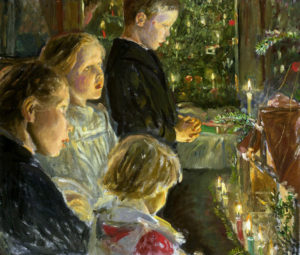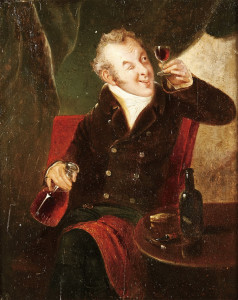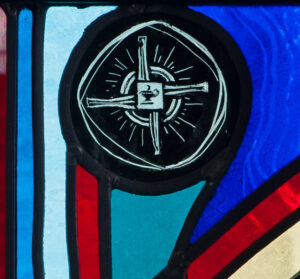We begin on Christmas Eve with angels and starry wonder and songs of peace, and yet, three days into our Christmastide journey, things take a distinctly darker shift. This Third Day of Christmas has, for centuries, been known as Childremas, or Children’s Mass. Our focus today is on children, but this comes out of a memorial of the most disturbing part of the Christmas story.
THIRD DAY of CHRISTMAS:
Holy Innocents’ Day, Childremas
The focus this Third Day of Christmas is on children, so go on: dote on your kids. Equally important, though, I think, is to reconnect this day and every now and again with the children we once were. At Christmas, we get to reconnect to our past and we get to speak, as Garrison Keillor once said, our very first language. Christmas bestows this gift upon us each year, and Childremas does this especially.
Here is the dark side of the story: When Herod, the Roman-appointed King of Judea, learned of the star over Bethlehem and the child that was born there –– a child who would be king –– he grew anxious about his throne. And these are some of the most dangerous people, are they not? Insecure people in positions of power who feel threatened. And so, the story goes, Herod dealt with the threat by ordering the slaughter of all the children of Judea. These children are remembered as the Holy Innocents, and another name for this day is Holy Innocents’ Day. It is traditionally thought of as the most unlucky day of the year. The day, in fact, was viewed with such great superstition in ages past that it was considered unlucky even to wear new clothes on the Third Day of Christmas, or to clip your fingernails, or to undertake any new project. Best to leave it for the following day, when good luck would return.
One of the oldest Christmas carols to survive through the ages is one that comes out of the sadness of Childremas: a poignant, touching lullaby called the “Coventry Carol.” (Go ahead: play it while you’re reading.) We don’t know who wrote the song but it appears in manuscripts in England as early as 1534, during the reign of Henry VIII. Joseph is warned by an angel in a dream to take his family to Egypt… but none of the other parents of Judea receive this warning. They are left to fend for themselves against Herod’s soldiers, and in this positively haunting carol, the mothers try to protect their children by quieting them, lulling them to sleep. Lully, lullah, thou little tiny child, Bye bye, lully, lullay. That woe is me, poor child, for thee, And ever mourn and may, For thy parting neither say nor sing, “Bye bye, lully, lullay.”
One thing is for sure: this is not the sort of song we think of today when we think of Christmas carols. For the Tudors, though, this song speaks to their experience. An awful lot of Tudor children died in infancy. Tudor mothers understood the Coventry Carol. They were no strangers to the pain experienced by the mothers in the Christmas story.
So, how do we best acknowledge this Third Day of Christmas, then? One important thing revolves around that word, acknowledge. Acknowledge, first of all, that this slaughter of the innocents continues to this day, and in this very same geography. These are the ways of men in power and holy innocents get caught in the crossfire.
I know not the solution. Closer to home, closer to our hearts, I think the best approach in remembrance of all those lost that first Christmas is to honor the children in our lives now, and the children we once were, too: to reconnect with a time when we were more willing to suspend disbelief, more willing to be fully immersed in things, as children are wont to be. We leave childhood behind because we have to. But the child you were has certainly informed the adult you’ve become, so there is a thread that resonates across the years. This is something worth nurturing. The happiest, most engaged people I know still retain a measure of the wonder they knew as children.
One of the oldest midwinter traditions in the Church is the election of a Boy Bishop each St. Nicholas’s Day on the Sixth of December. He would be chosen from the choirboys, and he would rule until Childremas, this Third Day of Christmas. The office was serious business. The Boy Bishop wore full vestments and mitre, and he would perform all the duties of a bishop, save for celebrating mass, although he did often deliver the sermons. The actual bishop would, in some places, have to follow the orders of the Boy Bishop. These traditions tap into the ideas of the Feast of Fools, as well, where the normal order of things is ceremoniously reversed (which blends into the customs for the Fourth Day of Christmas, tomorrow), and perhaps relates to the words of the Magnificat: God has put down the mighty from their throne and has exalted the humble and the meek.
In medieval times, the Boy Bishop could be found in most every cathedral in France, Britain and Germany during the Yuletide season. The custom was treated with such seriousness that if he should die while in office, the Boy Bishop received the same burial honors as a real bishop. The 1869 Chambers Brothers’ Book of Days gives mention to one unfortunate Boy Bishop who did come to his end while in office, telling us that a monument to his memory may be found on the north side of the nave at Salisbury Cathedral.
In Spain and Latin America, the Third Day of Christmas is a day for practical jokes, the victims of which being called inocentes, although sometimes it is the prankster that gets that name in a plea for forgiveness. No matter how you spend the day, the theme, it seems, is universal: celebrating and honoring children. If it’s the child inside, how do we go about doing that? Keep it simple, I’d say. Are there favorite things you used to do when you were a kid that you just don’t do anymore? What was your favorite book back then, or your favorite movie, or your favorite thing to eat? Today, Childremas, is a good day to go back and give those things another try. Make it a playdate with the child you were. Get yourselves reacquainted, whilst acknowledging the darkness and light that is fully part of this journey we call Christmas.
TWELVE DAYS of CHRISTMAS SALE
At our online shop, our Twelve Days of Christmas Sale brings you automatic markdowns on most of our authentic German handmade nutcrackers, pyramids, and incense smokers. We are running the sale for the full Twelve Days of Christmas, through the Sixth Day of January. If there are things you wanted that Santa couldn’t fit in his sleigh, well, we’re here to help (and to offer you our best prices of the year, too). CLICK HERE to shop!
Image: “Children by the Christmas Tree” by Leopold Graf von Kalckreuth. Oil on canvas, c. early 20th century. [Public domain] via Wikimedia Commons.


